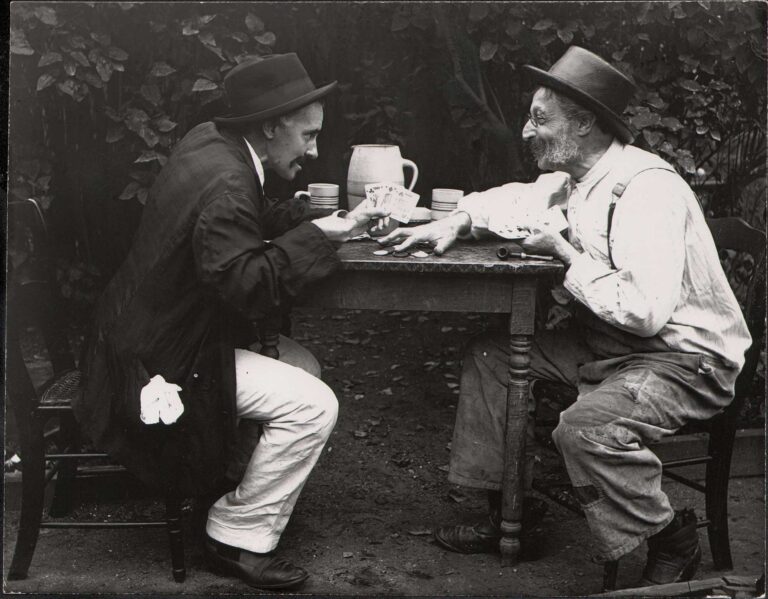
Model in Edwardian Dress
An Edwardian era model wearing a dress, lace shawl and hat is shown from the rear in this rare surviving studio photograph by Boston photographer John “Jack” H. Garo.
John H. Garo of Boston
“One of the greatest photographers in the history of the art” – Yousef Karsh (1.)
John Higue Garo: 1870–1939
It’s not known precisely when Armenian immigrant John Garo arrived in America after his birth around 1868 or 1870 in Ottoman Armenia, although his obituary states he was 14. In reporting by author Mehmed Ali for his superb 2016 volume Yousuf Karsh & John Garo: The Search for a Master’s Legacy, Garo first landed in Worcester, MA where he initially worked making barbed wire in one of the city’s mills. By 1889, Garo had traveled to Boston in search of more greener pastures and the following year “found a position as an artist with the Beckford Photo Studio at 43 Winter Street near Boston Common.” (2.)
Earlier in the introduction to the book, Jerry Fielder of the Karsh Estate wrote of the man Garo would become and the profession he would soon redefine: “John Garo was a renaissance man with many colors on his palette. He was an accomplished painter who embraced the modern age to become an extraordinary photographer. He was a rakish raconteur. He was dapper with more than a dash of dandy. He was an aesthete but also an athlete. He was an intellectual with an uninhibited sense of fun. He was impulsive at parties but took his friendships seriously. He was above all an artist with a palpable love of life and a focused devotion to his work.” (3.)
Similarly laudatory, a press release from Benna Books sent to this archive in December, 2015 before the books publication weighed in with the following, revealing the renaissance nature of Garo’s many talents, and reason enough today to keep his flame alive for modern audiences:
When President Calvin Coolidge was asked to choose between the artist John Singer Sargent or the photographer John Garo to make his official presidential portrait, Coolidge chose Garo. Although unknown today, in the early years of the twentieth century, Garo was a nationally acclaimed photographer, a leader in the thriving Boston photographic community. Cultured and charming, Garo also painted watercolors, wrote poetry and counted among his friends luminaries in the worlds of music and theater. (4.)
In 1974, Yousef Karsh wrote of his passion for preserving the archive of his mentor, with the majority of it still not located today. Perhaps those reading the following might inspire some future sleuthing to bring additional of Garo’s works to light for future audiences?
After Garo’s death I was saddened to learn that much of his work was dispersed, which meant that the sum of his life’s accomplishment was fragmented. For many years, I have been trying to get his work together so that the rest of the world may see and enjoy his art. I have long cherished the idea of gathering his prints and presenting them to a museum which would treasure them, and having an exhibition of his work. It would be a great pity to have his prints locked away where no one could enjoy them—especially the younger generation of photographers, who could benefit from his vision. (5.)
The following 1939 obituary clipping for Garo, most likely from a Boston newspaper, fills in additional details:
John H. Garo, Noted Boston Photographer, Dies in Hospital
The funeral of John H. Garo, an Armenian immigrant who has long been regarded as one of the master photographers of America, will be tomorrow afternoon at 2:30 at Waterman’s undertaking parlors, 497 Commonwealth av. Mr. Garo died yesterday morning at the City Hospital.
He was born in Horpoot, Armenia, the son of a Congregational minister and a direct descendant of five centuries of clergymen. At the age of 14 he came to this country and went to Worcester, where he obtained his first work illustrating valentines. A few years later he became a photographer’s apprentice in Boston. He studied at night, specializing in English and in painting. He gained a wide reputation as a landscape artist, but he was best known as a photographer.
In a class by himself in the realm of artistic photography, Garo for more than 40 years won many photographic honors in this country. He also won international reputation through exhibits in salons abroad. One of his best-known pictures was that of Calvin Coolidge, a favorite of Mrs. Coolidge, which was hung in the White House.
He won the gold medal offered by the Photographers Association of New England in 1914 for his portrait of George Bartlett, superintendent of the Boston Normal Art School. His skill won him many commissions from socially prominent persons and high officials.
He was among the pioneers in the development of photography who successfully used artificial aids for improving the effects. A great influence in the camera clubs of this city for more than 30 years–as a critic and adviser–he was ever ready to experiment with new equipment that would bring out the real art and beauty in photographic work.
Many of his paintings have hung in exhibition at his gallery at 739 Boylston st., and at the Boston City Club. He leaves his wife. They lived at 83 Perkins st., Jamaica Plain.
- Excerpt: In Search of Greatness: Reflections of Yousuf Karsh, By Yousef Karsh, University of Toronto Press, 1962
- Excerpt:, Mehmed Ali: Yousuf Karsh & John Garo: The Search for a Master’s Legacy, Benna Books, 2016, p. 35
- Ibid, From the Introduction by Jerry Fielder, p. 10.
- Benna Books, An Imprint of Applewood Books Inc. Carlisle, Massachusetts, Press release, December, 2015: Yousuf Karsh & John Garo – The Search for a Master’s Legacy, ISBN: 978-1-944038-00-7
- Excerpt:, Mehmed Ali: Yousuf Karsh & John Garo: The Search for a Master’s Legacy, Benna Books, 2016, p. 154



